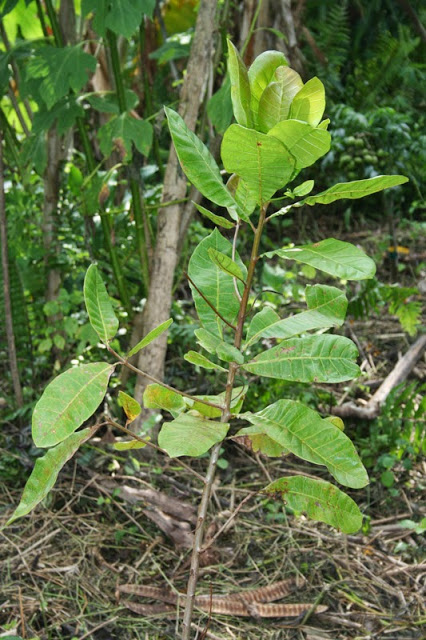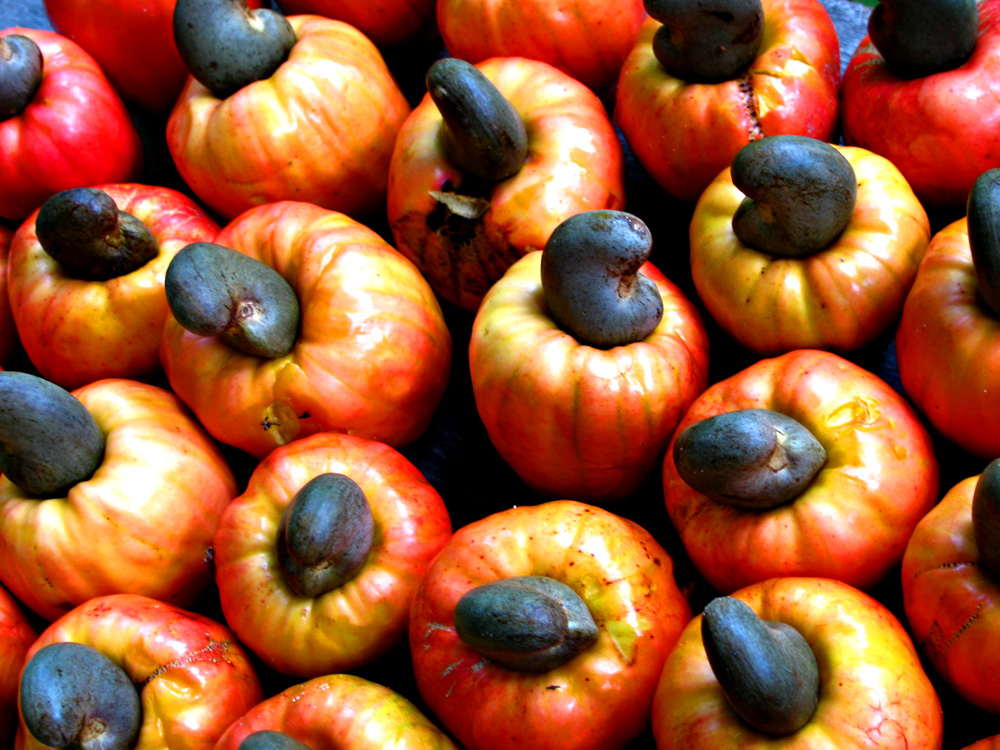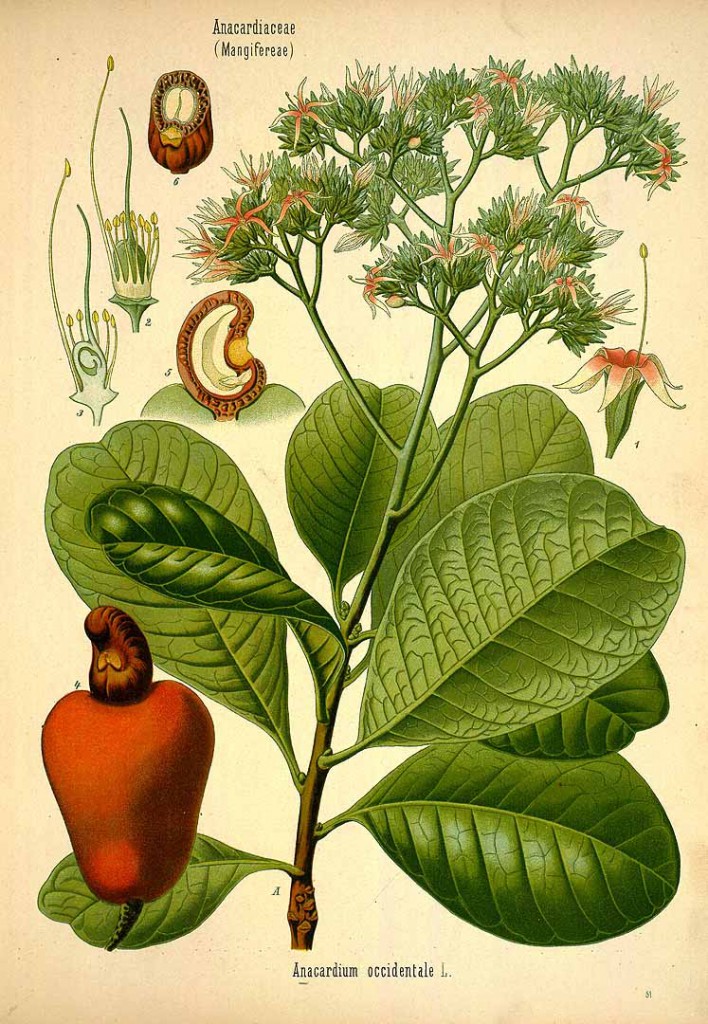For those of you living in the tropical portion of Florida, have you thought about growing cashews?
I have… but I’ve never had quite the big enough greenhouse to pull it off up here, so instead I planted a cashew tree in The Great South Florida Food Forest Project back in May.

I need to get down there to take some follow-up photos and do an update; however, I’m quite enthralled with the idea of growing cashews and I’m going to make it happen wherever we end up next.
Cashews aren’t a real nut, however. They’re a seed that grows at the end of a stem which looks like a fruit. Confused? Here’s an illustration:
It’s really a beautiful tree.
Related to mangoes, sumac, the much-hated Brazilian pepper and even poison ivy, cashews also have a dark side.
Though the fruits are edible, the seed (the cashew “nut” itself) is surrounded by a vicious toxin that will cause blisters and even blindness, making processing it to get the tasty nuts really a major pain – sometimes literally!
A publication from the South African Department of Agriculture says why:
Harvested nuts are dried in the sun for a few days. Properly dried nuts can be stored for 2 years before being shelled. Nuts are roasted to discharge the caustic shell oil and acrid fumes. Hand shelling is impossible if the shell oil has not been removed previously. Kernels must be protected from contamination by the shell oil because it would cause blisters in the mouth and throat when eaten. Before the nuts are roasted they must be soaked in water—the moisture in the shell facilitates the rupturing of the cells containing shell oil and retaining it in the shell. Moisture makes the kernel slightly rubbery and limits breakage of the kernels. The easiest method to wet the shells is to heap the nuts into big piles and to use sprinklers intermittently. Steam may also be used.
The simplest roasting method is to heat the nuts for about a minute in an open pan with holes. Acid fumes are released and if the nuts should catch fire the flames can be doused with water. A more efficient method is to use a slanting perforated cylinder that is rotated above a fire. The shell oil flows through the holes in the cylinder and is collected in a catch through. After the roasting process the nuts are dumped into ash or sawdust to remove the excess shell oil still clinging to the shells.
Yeah, Cashews are scary. The University of Florida actually warns against trying to process your own nuts:
Homeowners should not attempt shelling and consuming the cashew nut produced by cashew trees grown in the home landscape. The shell contains a reddish-brown, viscous, oily liquid composed of various phenolic lipids. This oil is poisonous and acts as a powerful vesicant, causing extensive blistering of the skin (dermatitis). Removal of the kernel from raw nuts requires special precautions and procedures. The sap from the wood, leaves, and flowers may also cause dermatitis and the smoke from burning any part of the tree is poisonous.
What’s life without a bit of sizzled skin? Those killjoys.
Growing Cashews
You can grow cashew trees from seed, though you’re never going to find good seed unless there’s a cashew growing in your neighborhood. The ones from the store are already quite processed, even the “raw” ones, obviously, or else there would be a lot of blistered faces and litigation.
The tree requires a year-round tropical climate and is a smaller size, ranging from 15 – 30′ tall. Perfect for a small lot.
I’m interested in growing cashews for the cashew apple, which is reportedly great for juicing – plus, the tree is just so beautiful and exotic as to make a great addition to a tropical food forest or backyard. Look at these beautiful things!

Photo credit Joao Vicente
Cashews can be grafted or air-layered to duplicate productive trees, since you don’t really know what you’ll get from a seed (though many trees are started this way and still do great!).
If you’d like to see how much work goes into the nuts we wantonly gobble down on car trips, check this video out:
I admit to feeling some shame over my blithe first-world consumption of cashew nuts… I didn’t realize how much of this process was done by hand and how very long it takes to process cashews.
Sometimes you don’t realize how rich you are.
Any of you all ever grow cashews or see a cashew tree in person?



12 comments
I have tried to buy seeds online, but the never germinated – must not be fresh enough to grow!
Also, I was searching your site for greenhouse growing in the winter and wasn’t finding too much. I am building a hoop house over a permanent garden bed (1/2 garden and the other 1/2 for my potted tropicals (bread fruit, starfruit, tropical almond, cinnamon, neem, a bunch of unknown seeds I brought from overseas, etc.). My question is: do you know what is good (vegetables) to plant in a greenhouse in the permanent garden bed here in north Florida? Is there enough light in the day to start and grow Cayenne or other peppers? What else besides greens?
Sorry for the long (and off-topic) post. I appreciate any help…
Good luck in the move – can’t wait until I get the chance to move further south and grow more tropicals…
I’ll answer this question in tomorrow’s post – stay tuned.
Awesome… standing by
When I moved to the Dominican Republic, there was a beautiful mature cashew tree in front of my little house. The fruits were lovely and large. About the same size as an apple. My neighbors came frequently to eat the fruit. They considered it a delicacy. Both Dave and I did not care for them. I do like cashew nuts so a neighbor showed us how to prepare the nuts. We did our best to stay away from the smoke which is known to kill chickens if they are close by. When I woke the following morning, my face looked like a moon. My eyes we almost swolen shut. It took a couple of days to recover. I had also read that if you have an allergy, eating cashews tends to magnify your symptoms.
Some years later, a hurricane knocked the tree on to my house. It is now gone but I don’t miss it much.
There are more exotic and better tasting fruits to grow that are less harmful. My favorite is zapote.
I was disappointed to learn that PSHTF there will be no more cashews for us. Not only is growing them in a greenhouse unrealistic but the amount of work & caustic compounds involved probably make it not worth the calories to process by the methods shown.
I visited a research facility in Guatemala that was trying cashews. The fresh fruit is wonderful, but only if 100% ripe. The slightest bit green and it puckers you up like a green persimmon. It is basically all juice, very tangy but not much flavor. In the heat very refreshing.
I live in southeast Texas. Since I love cashews I thought I might like growing a cashew tree. Now that I’ve read about how caustic they are, think I’ll stick to buying them one can at a time.K
Yeah, they really are a ton of work and tough to handle. I haven’t bothered processing them either.
Our neighbor had a cashew tree when I was young. My mom disliked the tree because it almost always had a colony of brown ants running up and down it. I didn’t mind; the cashew apples were very juicy and delicious so what was a tiny sting or two? Some of the neighbourhood kids would often pool nuts together for roasting but we almost always got charred nuts because the oil always caught fire and burnt the nuts before we could rescue them. In retrospect, this probably wasn’t an activity for kids but hey, this was the 80’s!
I’m growing a few trees but this time, I’m not going to bother with the nuts. The juice from the apple makes a really good fruit punch!
That is a really cool story. I never even saw a cashew tree until I was in my 30s. I have a small tree I started which I’m going to plant on my new land… it will great to try making some punch.
interesting write up.. first cashew trees I ever saw was while on vacation in Belize. They were growing all over like weeds in the middle of nowhere. I’ll be buying a couple trees to plant here in N Fla.
I don’t think they’ll live there – you would have to put them in a greenhouse.
Comments are closed.